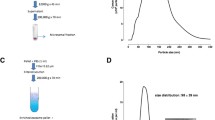Abstract
A major challenge in develo** potential treatments for pregnancy complications is minimizing adverse effects to the fetus and mother. Placenta-targeted drug delivery could reduce the risks of drug treatments in pregnancy by targeting tissue where most pregnancy complications originate and decreasing dosages. We previously developed a tool for the targeted delivery of drug-carrying nanoparticles to the placenta using a synthetic placental chondroitin sulfate A-binding peptide (plCSA-BP) derived from the malarial protein VAR2CSA, which binds a distinct type of chondroitin sulfate A (CSA) exclusively expressed by placental trophoblasts. Liposomes are a type of nanoparticle already approved for use in humans by the Food and Drug Administration (FDA) and used successfully for the treatment of a wide range of diseases. Here, we present a detailed method to create plCSA-BP-decorated liposomes that can be used to deliver drugs specifically to placental trophoblasts. Liposomes are first generated by the standard film method and then conjugated to plCSA-BPs using the 1-ethyl-3-(3-dimethylaminopropyl) carbodiimide hydrochloride/N-hydroxysulfosuccinimide (EDC/NHS) bioconjugate technique. This protocol may facilitate bench-to-bedside translation of drug discovery for the treatment of pregnancy disorders by reducing risks of side effects, and enabling rapid and scalable production.
Access this chapter
Tax calculation will be finalised at checkout
Purchases are for personal use only
Similar content being viewed by others
References
King A, Ndifon C, Lui S et al (2016) Tumor-homing peptides as tools for targeted delivery of payloads to the placenta. Sci Adv 2:e1600349
Beards F, Jones LE, Charnock J et al (2017) Placental homing peptide-microRNA inhibitor conjugates for targeted enhancement of intrinsic placental growth signaling. Theranostics 7:2940–2955
Kaitu’u-Lino TJ, Pattison S, Ye L et al (2013) Targeted nanoparticle delivery of doxorubicin into placental tissues to treat ectopic pregnancies. Endocrinology 154:911–919
Cureton N, Korotkova I, Baker B et al (2017) Selective targeting of a novel vasodilator to the uterine vasculature to treat impaired Uteroplacental perfusion in pregnancy. Theranostics 7:3715–3731
Wathes DC, Borwick SC, Timmons PM et al (1999) Oxytocin receptor expression in human term and preterm gestational tissues prior to and following the onset of labour. J Endocrinol 161:143–151
Salanti A, Staalsoe T, Lavstsen T et al (2003) Selective upregulation of a single distinctly structured var gene in chondroitin sulphate A-adhering Plasmodium falciparum involved in pregnancy-associated malaria. Mol Microbiol 49:179–191
Salanti A, Clausen TM, Agerbæk M et al (2015) Targeting human cancer by a glycosaminoglycan binding malaria protein. Cancer Cell 28:500–514
Zhang B, Tan L, Yu Y et al (2018) Placenta-specific drug delivery by trophoblast-targeted nanoparticles in mice. Theranostics 8:2765–2781
Zhang B, Cheng G, Zheng M et al (2018) Targeted delivery of doxorubicin by CSA-binding nanoparticles for choriocarcinoma treatment. Drug Deliv 25:461–471
Bozzuto G, Molinari A (2015) Liposomes as nanomedical devices. Int J Nanomedicine 10:975–999
Alavi M, Karimi N, Safaei M (2017) Application of various types of liposomes in drug delivery systems. Adv Pharm Bull 7:3–9
Sercombe L, Veerati T, Moheimani F et al (2015) Advances and challenges of liposome assisted drug delivery. Front Pharmacol 6:286
Gebre MS, Brito LA, Tostanoski LH et al (2021) Novel approaches for vaccine development. Cell 184:1589–1603
Allen TM, Cullis PR (2013) Liposomal drug delivery systems: from concept to clinical applications. Adv Drug Deliv Rev 65:36–48
Totaro KA, Liao X, Bhattacharya K et al (2016) Systematic investigation of EDC/sNHS-mediated bioconjugation reactions for carboxylated peptide substrates. Bioconjug Chem 27:994–1004
Nair M, Johal RK, Hamaia SW et al (2020) Tunable bioactivity and mechanics of collagen-based tissue engineering constructs: a comparison of EDC-NHS, genipin and TG2 crosslinkers. Biomaterials 254:120109
Surendran SP, Thomas RG, Moon MJ et al (2020) A bilirubin-conjugated chitosan nanotheranostics system as a platform for reactive oxygen species stimuli-responsive hepatic fibrosis therapy. Acta Biomater 116:356–367
Liu EY, Jung S, Yi H (2016) Improved protein conjugation with uniform, macroporous poly(acrylamide-co-acrylic acid) hydrogel microspheres via EDC/NHS chemistry. Langmuir 32:11043–11054
Hermanson GT (2013) Bioconjugate techniques. Academic press
Pabst G, Kučerka N, Nieh M-P et al (2014) Liposomes, lipid bilayers and model membranes: from basic research to application. CRC Press
Basu SC, Basu M (2002) Liposome methods and protocols. Springer Science & Business Media
Patil YP, Jadhav SJC, Lipids PO (2014) Novel methods for liposome preparation. Chem Phys Lipids 177:8–18
Altintas I, Heukers R, Van Der Meel R et al (2013) Nanobody-albumin nanoparticles (NANAPs) for the delivery of a multikinase inhibitor 17864 to EGFR overexpressing tumor cells. J Control Release 165:110–118
Chen H, Gao J, Lu Y et al (2008) Preparation and characterization of PE38KDEL-loaded anti-HER2 nanoparticles for targeted cancer therapy. J Control Release 128:209–216
Zhang L, Chan JM, Gu FX et al (2008) Self-assembled lipid− polymer hybrid nanoparticles: a robust drug delivery platform. ACS Nano 2:1696–1702
Rane SS, Choi P (2005) Polydispersity index: how accurately does it measure the breadth of the molecular weight distribution? Chem Mater 17:926–926
Samimi S, Maghsoudnia N, Eftekhari RB et al (2019) Chapter 3 – Lipid-based nanoparticles for drug delivery systems. In: Mohapatra SS, Ranjan S, Dasgupta N, Mishra RK, Thomas S (eds) Characterization and biology of nanomaterials for drug delivery. Elsevier, Amsterdam, pp 47–76
Acknowledgments
The work was supported by grants from the National Natural Science Foundation of China (82302374), March of Dimes Birth Defects Foundation and the Preeclampsia Foundation to NRN at Stanford University and WSU. NRN is supported by the NICHD grant #R01HD088549 at WSU and UMKC (the content is solely the responsibility of the authors and does not necessarily represent the official views of the US National Institutes of Health).
Author information
Authors and Affiliations
Editor information
Editors and Affiliations
Rights and permissions
Copyright information
© 2024 The Author(s), under exclusive license to Springer Science+Business Media, LLC, part of Springer Nature
About this protocol
Cite this protocol
Zhang, B., Fan, X., Nayak, N.R. (2024). Trophoblast-Targeted Liposomes for Placenta-Specific Drug Delivery. In: Raha, S. (eds) Trophoblasts. Methods in Molecular Biology, vol 2728. Humana, New York, NY. https://doi.org/10.1007/978-1-0716-3495-0_15
Download citation
DOI: https://doi.org/10.1007/978-1-0716-3495-0_15
Published:
Publisher Name: Humana, New York, NY
Print ISBN: 978-1-0716-3494-3
Online ISBN: 978-1-0716-3495-0
eBook Packages: Springer Protocols




